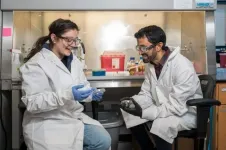(Press-News.org) Findings from a study published today [6 July] in the Journal of the American Medical Association (JAMA) have prompted new World Health Organization (WHO) recommendations to use interleukin-6 antagonists in patients with severe or critical COVID-19 along with corticosteroids.
A new analysis of 27 randomised trials involving nearly 11,000 patients found that treating hospitalised COVID-19 patients with drugs that block the effects of interleukin-6 (the interleukin-6 antagonists tocilizumab and sarilumab) reduces the risk of death and the need for mechanical ventilation.
The study, which was coordinated by WHO in partnership with King's College London, University of Bristol, University College London and Guy's and St Thomas' NHS Foundation Trust, found that interleukin-6 antagonists were most effective when administered with corticosteroids. In hospitalised patients, administering one of these drugs in addition to corticosteroids reduces the risk of death by 17%, compared to the use of corticosteroids alone. In patients not on mechanical ventilation, the risk of mechanical ventilation or death is reduced by 21%, compared to the use of corticosteroids alone.
In severely ill COVID-19 patients, the immune system overreacts, generating cytokines such as interleukin-6. Clinical trials have been testing whether drugs that inhibit the effects of interleukin-6, such as tocilizumab and sarilumab, benefit hospitalised patients with COVID-19. These trials have variously reported benefit, no effect and harm.
This prompted researchers from WHO's Rapid Evidence Appraisal for COVID-19 Therapies [REACT] Working Group, to examine the clinical benefit of treating hospitalised COVID-19 patients with interleukin-6 antagonists, compared with either a placebo or usual care. They combined data from 27 randomised trials that were conducted in 28 countries.
This analysis included information on 10,930 patients, of whom 6,449 were randomly assigned to receive interleukin-6 antagonists and 4,481 to receive usual care or placebo.
Results showed that the risk of dying within 28 days is lower in patients receiving interleukin-6 antagonists. In this group, the risk of death is 22% compared with an assumed risk of 25% in those receiving only usual care.
Importantly, improvements in outcomes were greater in patients who also received corticosteroids. In these patients, the risk of dying within 28 days is 21% in patients receiving interleukin-6 antagonists compared with an assumed 25% in patients receiving usual care. This means that for every 100 such patients, four more will survive.
The study also looked at the effect of these drugs on whether patients progressed to mechanical ventilation or death. Among patients also treated with corticosteroids, the risk was found to be 26% for those receiving interleukin-6 antagonists compared with an assumed 33% in those receiving usual care. This means that for every 100 such patients, 7 more will survive and avoid mechanical ventilation.
Commenting on the results of the analysis Dr Janet Diaz, Lead for Clinical management, WHO Health Emergencies, said: "Bringing together the results of trials conducted around the world is one of the best ways to find treatments that will help more people survive COVID-19. We have updated our clinical care treatment guidance to reflect this latest development. While science has delivered, we must now turn our attention to access. Given the extent of global vaccine inequity, people in the lowest income countries will be the ones most at risk of severe and critical COVID-19. Those are the people these drugs need to reach."
Prof Manu Shankar-Hari, Critical Care Consultant at Guy's and St Thomas' Hospital NHS Foundation Trust, Professor of Critical Care Medicine at King's College London and a NIHR Clinician Scientist, said: "COVID-19 is a serious illness. Our research shows that interleukin-6 antagonists reduce deaths from COVID-19, i.e. save lives, and prevent progression to severe illness necessitating breathing support with a ventilator. Further, interleukin-6 antagonists appear even more effective when used alongside corticosteroids. Our research findings reflect the incredible research effort from scientists worldwide since the start of the pandemic. On a personal note, I am grateful to the patients and their families for their willingness to participate in research during these challenging times."
Jonathan Sterne, Professor of Medical Statistics and Epidemiology, University of Bristol, Deputy Director of the National Institute for Health Research Bristol Biomedical Research Centre (NIHR Bristol BRC) and Director of Health Data Research UK South West, said: "Clinical trials assessing the efficacy of monoclonal antibodies that block interleukin-6 in hospitalised patients with COVID-19 have variously reported benefit, no effect and harm. By rapidly combining 95 per cent of the worldwide data from these trials, we have shown that these drugs work consistently in reducing death and severe COVID-19 disease across countries and health care settings, and that they work better among patients who are also receiving corticosteroids."
Claire Vale, Principal Research Fellow at the MRC Clinical Trials Unit at UCL (University College London), said: "These results, which will lead to better outcomes for patients hospitalized with COVID-19, reflect a huge global effort. Bringing together this information in such a short space of time has only been possible thanks to the overwhelming commitment of all the doctors and teams who ran the trials, and of course, the patients who took part in them."
INFORMATION:
ITHACA, N.Y. - As offices nationwide spring back to life, interior space designers and architects will soon have an easy-to-use planning tool to place indoor workplace furniture, staff, partitions and ventilation in a manner that maximizes fresh air flow and reduces the risk of airborne pathogens.
The Cornell Environmental Systems Lab in the College of Architecture, Art and Planning will introduce a new indoor module for their existing Eddy3D software, a professional-level airflow and microclimate simulator that can help improve ventilation.
The new indoor module will be released this summer, while the research supporting it will ...
Scientists and engineers are constantly looking for ways to better our world.
Synthetic biology is an emerging field with promise for improving our ability to manufacture chemicals, develop therapeutic medicines such as biopharmaceuticals and vaccines, and enhance agricultural production, among other things. It relies on taking natural or engineered pieces of DNA and combining them in new ways in biological systems, such as microbes, bacteria or other organisms.
According to University of Delaware's Aditya Kunjapur, assistant professor of chemical and biomolecular engineering, as these sophisticated microbial technologies are advanced, scientists need to explore ways to keep these organisms from ending up in the wrong environment.
For example, a bacterium that is good at making ...
UNIVERSITY PARK, Pa. -- What if the COVID-19 virus could be used against itself? Researchers at Penn State have designed a proof-of-concept therapeutic that may be able to do just that. The team designed a synthetic defective SARS-CoV-2 virus that is innocuous but interferes with the real virus's growth, potentially causing the extinction of both the disease-causing virus and the synthetic virus.
"In our experiments, we show that the wild-type [disease-causing] SARS-CoV-2 virus actually enables the replication and spread of our synthetic virus, thereby effectively promoting its own decline," said Marco Archetti, associate professor of biology, Penn State. "A version of this synthetic construct could be used as a self-promoting ...
UNIVERSITY PARK, Pa. -- The fast-moving decline and extinction of many species of detritivores -- organisms that break down and remove dead plant and animal matter -- may have dire consequences, an international team of scientists suggests in a new study.
The researchers observed a close relationship between detritivore diversity and plant litter decomposition in streams, noting that decomposition was highest in waters with the most species of detritivores -- including aquatic insects such as stoneflies, caddisflies, mayflies and craneflies, and crustaceans such as scuds and freshwater shrimp and crabs.
Decomposition ...
ABINGTON, Pa. -- Counterfeit dominance decreases Anglo-American, but not Asian, consumers' quality perception and purchase intention of authentic brands, according to a team of researchers.
"Counterfeit dominance is the perception that counterfeit products possess more than 50% of market share," Lei Song, assistant professor of marketing at Penn State Abington, said. "Counterfeit dominance is a phenomenon especially concerning for the luxury fashion industry as counterfeit luxury fashion brands account for 60% to 70% of the $4.5 trillion in total counterfeit trade and one-quarter of total sales in luxury fashion goods."
Lei and his team conducted four behavioral experiments with 149 participants on ...
Increased labour mobility seems to have stopped the racial wage discrimination of black English football players. A new study in economics from Stockholm university and Université Paris-Saclay used data from the English Premier League to investigate the impact of the so-called "Bosman ruling", and found that racial discrimination against English football players disappeared - but not for non-EU players. The study was recently published in the journal European Economic Review.
In 1995, the so-called Bosman ruling turned the labour market for European footballers upside down, introducing a free transfer ...
Necessity is the father of invention, but where is its mother? According to a new study published in Science, fewer women hold biomedical patents, leading to a reduced number of patented technologies designed to address problems affecting women.
While there are well-known biases that limit the number of women in science and technology, the consequences extend beyond the gender gap in the labour market, say researchers from McGill University, Harvard Business School, and the Universidad de Navarra in Barcelona. Demographic inequities in who gets to invent lead to demographic inequities in who benefits from invention.
"Although the percentage of biomedical patents held by women has risen from 6.3% to 16.2% over the last three decades, ...
Researchers from Pompeu Fabra University (Barcelona, Spain) have analysed the way citizen science is practised in Spain. The paper, produced by Carolina Llorente and Gema Revuelta, from UPF's Science, Communication and Society Studies Centre (CCS-UPF) and Mar Carrió, from the University's Health Sciences Educational Research Group (GRECS), has been published in the Journal of Science Communication (JCOM).
Based on the study, a series of recommendations have been put forward to improve how citizen participation in science is carried out. Firstly, they suggest efforts be stepped up regarding the training given for assessing these initiatives or the creation of multi-disciplinary teams with a broad range of ...
Using an exceptionally preserved fossil from South Africa, a particle accelerator, and high-powered x-rays, an international team including a University of Minnesota researcher has discovered that not all dinosaurs breathed in the same way. The findings give scientists more insight into how a major group of dinosaurs, including well-known creatures like the triceratops and stegosaurus, evolved.
The study is published in eLife, a peer-reviewed open access scientific journal for the biomedical and life sciences.
Not all animals use the same techniques and organs to breathe. Humans expand and contract their ...
Researchers have shown how worms learn to optimise their foraging activity by switching their response to pheromones in the environment, according to a report published today in eLife.
The findings are an important advance in the field of animal behaviour, providing new insights on how sensory cues are integrated to facilitate foraging and navigation.
Foraging food is one of the most critical yet challenging activities for animals, with food often patchily distributed and other animals trying to find and consume the same resources.
An important consideration is how long to stay and exploit a food patch before moving on to find another. Leaving incurs the cost ...


